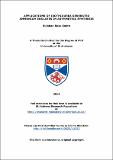Files in this item
Applications of isothiourea generated ammonium enolates in asymmetric synthesis
Item metadata
| dc.contributor.advisor | Smith, Andrew David | |
| dc.contributor.author | Smith, Siobhan Rose | |
| dc.coverage.spatial | 205 p. | en_US |
| dc.date.accessioned | 2017-08-23T13:58:55Z | |
| dc.date.available | 2017-08-23T13:58:55Z | |
| dc.date.issued | 2014 | |
| dc.identifier | uk.bl.ethos.722976 | |
| dc.identifier.uri | https://hdl.handle.net/10023/11532 | |
| dc.description.abstract | This thesis describes expansion of the ability of isothioureas to act as organocatalysts in formal [2+2]-, [3+2]- and [4+2]-cycloadditions between carboxylic acids and various acceptors via Type I ammonium enolate intermediates. Chapter 2 describes the optimisation and investigation of [2+2]-cycloadditions from ammonium enolates and N-sulfonylimines as the two components. The development of this methodology allows successful access to highly stereodefined β-lactams and, following in situ ring-opening, β-aminoesters. The products are obtained from either preformed homoanhydrides or directly from carboxylic acids, using open flask conditions, from simple, bench-stable starting materials and is scalable. A variety of anti-β-lactams (21 examples, 46-68% yield, up to >95:5 dr, 21->99% ee) and β-aminoesters (9 examples, 44-74% yield, up to >95:5 dr, 68-92% ee) were accessed in moderate yield, excellent diastereo- and good enantioselectivity. This represents an improved route to anti-β-lactams over previously described ketene and N-triflyl imine based methods. Chapter 3 subsequently describes studies focussed on the use of ester surrogates in the formal [4+2]-cycloaddition reactions of isothiourea generated Type I ammonium enolates. Iso-propylphosphonate 163 proved highly effective as the four-component in this process, which following the in situ ring-opening of the initial dihydropyranone product allowed isolation of a range of novel diester products which were previously unobtainable using this methodology. The products were accessed in moderate to excellent yields, excellent diastereo- and enantiocontrol (9 examples, 12-63% yield, up to >95:5 dr, 67-99% ee) with this process also amenable to a large scale. Furthermore, selective reduction and acid-catalysed cyclisation allowed access to δ-lactone products in good yield with retention of stereocontrol. Finally, Chapter 4 describes work on isothiourea-catalysed formal [3+2]-cycloadditions of oxaziridines and acetic anhydrides gave access to stereodefined five-membered oxazolidin-4-one heterocycles. In this case, the use of preformed homoanhydrides and an inorganic base was imperitive to avoid reduction of the oxaziridine starting material. The oxazolidin-4-one products could be accessed in excellent yield and ee however poor dr (13 examples, 63-96% yield, up to 59:41 dr anti:syn, up to >99% ee for both diastereoisomers). Following isolation, reduction of these heterocycles allowed access to enantioenriched diols with little loss in stereocontrol. Mechanistic analysis has shown that an improvement in diasterocontrol can be obtained by the use of an enantioenriched oxaziridine, demonstrating the stereospecificity of this process. | en_US |
| dc.language.iso | en | en_US |
| dc.publisher | University of St Andrews | |
| dc.subject.lcc | QD305.A6S6 | |
| dc.subject.lcsh | Enols | en |
| dc.subject.lcsh | Asymmetric synthesis | en |
| dc.subject.lcsh | Catalysts | en |
| dc.subject.lcsh | Organic compounds | en |
| dc.title | Applications of isothiourea generated ammonium enolates in asymmetric synthesis | en_US |
| dc.type | Thesis | en_US |
| dc.contributor.sponsor | Engineering and Physical Sciences Research Council (EPSRC) | en_US |
| dc.contributor.sponsor | GlaxoSmithKline | en_US |
| dc.type.qualificationlevel | Doctoral | en_US |
| dc.type.qualificationname | PhD Doctor of Philosophy | en_US |
| dc.publisher.institution | The University of St Andrews | en_US |
This item appears in the following Collection(s)
Items in the St Andrews Research Repository are protected by copyright, with all rights reserved, unless otherwise indicated.

